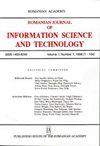AHB互连-功能验证
IF 3.9
4区 计算机科学
Q1 COMPUTER SCIENCE, THEORY & METHODS
Romanian Journal of Information Science and Technology
Pub Date : 2023-09-28
DOI:10.59277/romjist.2023.3-4.04
引用次数: 0
摘要
本文对高级高性能总线(AHB)互连模块集成的验证程序进行了深入的探讨。验证过程在芯片开发中具有关键意义,需要在进入批量生产阶段之前对硬件设计进行彻底的验证和检查。此验证过程的主要目标是一丝不苟地挖掘设计中嵌入的潜在错误或缺陷,这些错误或缺陷可能潜在地触发不期望的结果,降低性能,甚至是最终产品中的严重故障。这种验证方法的核心是功能验证范例,以基于模拟的测试为中心。在这个框架中,AHB Interconnect模块在一个受控的验证环境中被实例化,该环境被设计用来模拟真实世界的场景。该环境将输入刺激编排到模块,并捕获由模块生成的后续输出。环境经过精心编程,可以预测模块的特定行为模式。与这些预期行为的偏差被迅速标记为错误。这种细致的方法可以保证模块与其预期的操作保持一致,并严格遵守预定义的功能基准。这篇论文是献给Florin georghe Filip院士,在他担任罗马尼亚科学院信息科学与技术部主席15周年,以及他的75周年纪念日。本文章由计算机程序翻译,如有差异,请以英文原文为准。
AHB Interconnect - Functional Verification
This paper offers an in-depth exploration of the verification procedure pertaining to the integration of an Advanced High-performance Bus (AHB) Interconnect module. The verification process holds pivotal significance within chip development, entailing thorough validation and examination of the hardware design before entering the mass production phase. The principal objective of this verification process is to meticulously unearth potential bugs or imperfections embedded in the design, which could potentially trigger undesirable outcomes, compromised performance, or even critical malfunctions in the final product. At the heart of this verification approach lies the functional verification paradigm, centered around simulation-based testing. Within this framework, the AHB Interconnect module is instantiated in a controlled verification environment designed to emulate real-world scenarios. This environment orchestrates input stimuli to the module and captures ensuing outputs generated by it. The environment is meticulously programmed to anticipate specific behavioral patterns from the module. Deviations from these anticipated behaviors are promptly flagged as errors. This meticulous methodology serves to guarantee that the module aligns with its intended operations and strictly adheres to predefined functional benchmarks. The paper is dedicated to Acad. Florin Gheorghe Filip, at his 15th anniversary as the Chairman of the Information Science and Technology Section of the Romanian Academy, and at his 75th anniversary.
求助全文
通过发布文献求助,成功后即可免费获取论文全文。
去求助
来源期刊

Romanian Journal of Information Science and Technology
工程技术-计算机:理论方法
CiteScore
5.50
自引率
8.60%
发文量
0
审稿时长
>12 weeks
期刊介绍:
The primary objective of this journal is the publication of original results of research in information science and technology. There is no restriction on the addressed topics, the only acceptance criterion being the originality and quality of the articles, proved by independent reviewers. Contributions to recently emerging areas are encouraged.
Romanian Journal of Information Science and Technology (a publication of the Romanian Academy) is indexed and abstracted in the following Thomson Reuters products and information services:
• Science Citation Index Expanded (also known as SciSearch®),
• Journal Citation Reports/Science Edition.
 求助内容:
求助内容: 应助结果提醒方式:
应助结果提醒方式:


